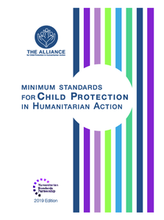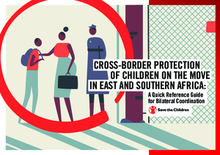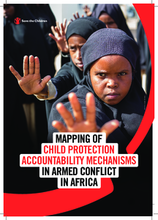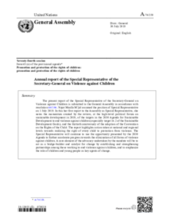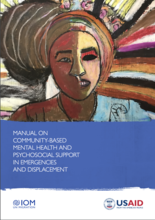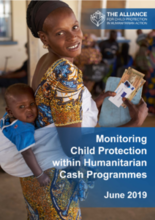Displaying 191 - 200 of 496
The Minimum Standards for Child Protection in Humanitarian Action (CPMS), originally launched in 2012, set out a common agreement on what needs to be achieved in order for child protection in humanitarian settings to be of adequate quality. Years of implementing the CPMS in diverse settings revealed the need for a more user-friendly version of the Standards that would reflect recent sector learning and evidence; improve guidance on prevention, gender and age inclusion, and other cross-cutting themes; and promote applicability to a broader range of humanitarian contexts. Therefore, the Standards were updated in 2019 through a two-year revision process.
This Quick Reference Guide is a practical guide for all stakeholders who hope to implement a government-led, cross-border coordination mechanism for the protection of children who are unaccompanied and separated while in situations of migration or displacement.
The aim of this module from the book Rights-based Integrated Child Protection Service Delivery Systems is to learn about the child protection services needed during armed conflicts.
The aim of this module from the book Rights-based Integrated Child Protection Service Delivery Systems is to learn about children in specific situations of emergency and the need for Integrated Child Protection Centres to provide rights-based services for them at primary, secondary and tertiary levels of prevention.
This general comment from the UN Committee on the Rights of the Child addresses children's rights in the child justice system. The general comment notes several concerns and recommendations regarding the deprivation of liberty of children, including the consideration of the child's best interests, the need to promote successful reintegration of children, and the recognition of the harm caused by deprivation of liberty.
This report presents findings from a mapping of the relevant means of holding actors accountable for violations committed against children by assessing the child protection-relevant accountability mechanisms in situations of armed conflict in Africa.
In the present report, the Special Rapporteur seeks to highlight the situation of internally displaced children who are suffering and dying because of the lack of rapid and appropriate responses to their specific needs and protection concerns and the lack of capacity and resources to fill protection gaps on the part of humanitarian actors.
This report of the Special Representative of the Secretary-General on Violence against Children highlights action taken at national and regional levels towards realizing the right of every child to protection from violence.
The present Manual aims to facilitate mental health and psychosocial support (MHPSS) experts and managers in designing, implementing and evaluating community-based MHPSS (CB MHPSS) programmes, projects and activities for emergency-affected and displaced populations in humanitarian settings.
This paper from the Alliance for Child Protection in Humanitarian Action summarises findings from an initial scoping study, which seeks to review how child protection outcomes are captured when monitoring multi-purpose humanitarian cash programmes. The paper proposes a theory of change of the possible links between cash and child protection to inform the development of a monitoring strategy, including hypotheses that humanitarian cash might contribute to prevention of family separation, reduction of family violence, and supporting foster and temporary caregivers to care for separated and unaccompanied children.

